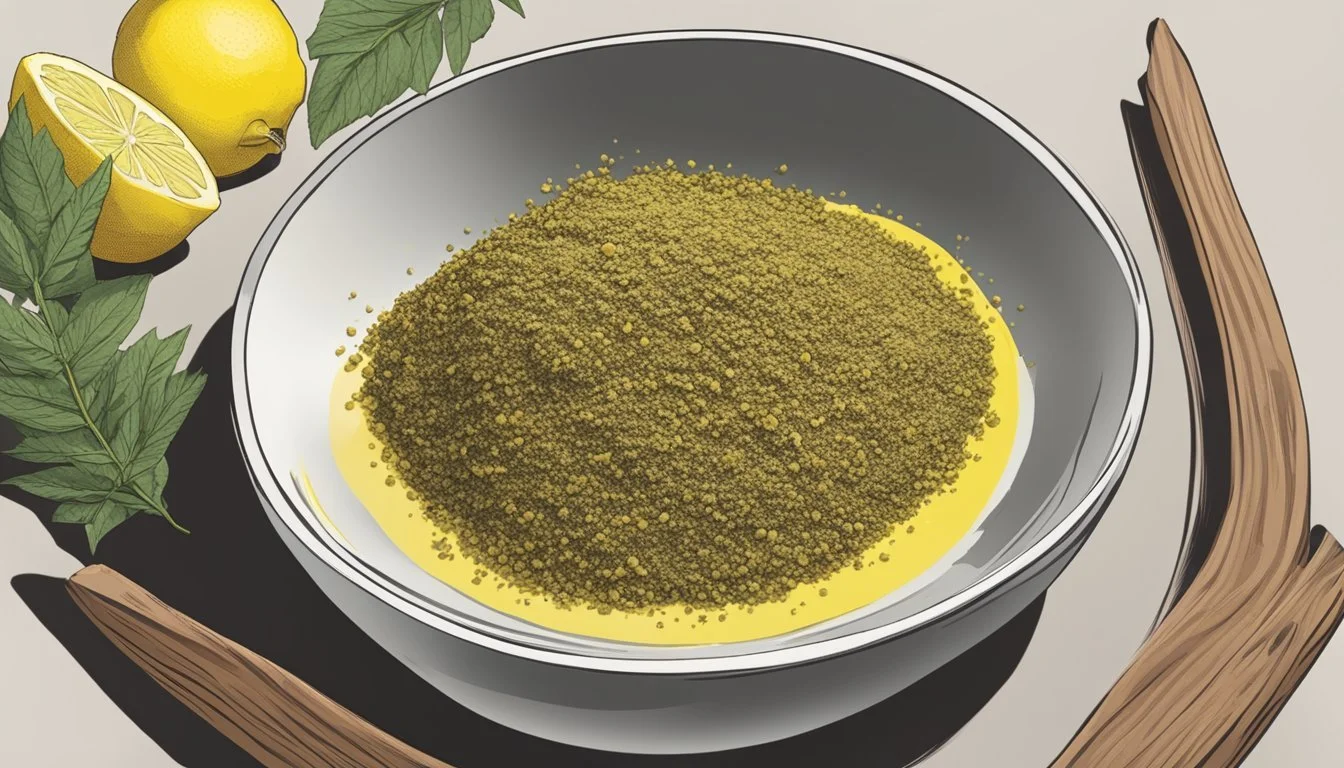How to Substitute Sumac for Lemon Zest
A Flavorful Alternative Guide
Sumac is a tangy, lemony spice often used in Middle Eastern cuisine, particularly to add zest and color to a variety of dishes. Its deep red berries are ground into a coarse powder that imparts a sourness similar to lemon, which makes it an excellent way to brighten the flavors in a recipe. In the absence of sumac, one may seek substitutes that provide a similar acidic kick to dishes.
Lemon zest is a commonly recommended alternative to sumac for its ability to offer that desired citrus note. Derived from the outer skin of lemons, the zest contains the fruit’s essential oils, which are responsible for its vibrant, fresh citrus flavor. When sumac is not available, using lemon zest appropriately can help replicate the original dish’s intended taste profile while also providing a visually appealing hint of color.
To successfully incorporate lemon zest as a substitute for sumac, one must consider the balance of flavor in the original recipe. Although sumac is a bit more nuanced than lemon zest—with an earthy undertone to its tartness—judicious use of lemon zest can still provide an acceptable flavor parallel. It's important to account for the difference in texture and to adjust quantities as needed to achieve the desired result.
Understanding Sumac
Before diving into the use of lemon zest as a substitute, it's important to have a grasp on sumac itself, a quintessential spice prevalent in Middle Eastern cuisine that offers both distinct flavor and health benefits.
Origins and Culinary Use
Sumac is derived from the berries of the Rhus coriaria plant, which is native to Middle Eastern regions. In culinary settings, it is often dried, ground into a coarse powder, and utilized as a spice to add a sour and tangy profile to a variety of dishes. Middle Eastern cuisine especially favors sumac for its ability to enhance flavors in meat dishes, salads, and rice.
Common uses include:
Seasoning for grilled meats
Garnish on salads and dips
Flavoring for rice and other grains
Taste Profile and Health Benefits
The flavor of sumac is best described as tart, slightly acidic, and reminiscent of lemon, with a deep red hue that contributes a vibrant aesthetic to food. It holds a considerable amount of antioxidants, which combat oxidative stress in the body, and is a good source of vitamin C.
Health attributes of sumac:
High in antioxidants
Contains vitamin C
Potentially anti-inflammatory
Sumac not only imparts its distinctive zesty flavor but also brings a pop of color to dishes, setting them apart with both taste and visual appeal.
The Role of Lemon Zest in Cooking
In the culinary world, lemon zest is heralded for its ability to infuse dishes with a bright, citrusy essence that is both distinctive and aromatic. The zest carries the highest concentration of oils in the lemon, contributing a potent burst of flavor work best in a wide range of recipes.
Flavor Characteristics
Lemon zest possesses a vibrant flavor profile that is tangy, bright, and slightly sweet. This zest, the outermost part of the rind, contains the fruit's essential oils, which deliver an intense lemon fragrance and flavor. Unlike the juice, it doesn't add liquid to a dish, which makes it particularly useful in instances where additional moisture could adversely affect the recipe's texture.
Common Uses in Recipes
Lemon zest often plays a pivotal role in a variety of recipes, acting as a key ingredient that provides a fresh, zesty kick. Its uses include:
Desserts and Baked Goods: Works perfectly to add a citrus note to cakes, cookies, and other sweets.
Sauces and Dressings: Infuses a bright accent to vinaigrettes, marinades, and sauces.
Savory Dishes: Enhances meat, seafood, and vegetable dishes with its refreshing tartness.
Cocktails and Beverages: Utilized as a garnish or flavor agent in many drinks for a citrus zing.
Incorporating lemon zest into recipes taps into the fruit's citrus properties without altering the moisture balance, crucial for achieving the desired taste and texture in many dishes.
Sumac as a Substitute for Lemon Zest
When a recipe calls for lemon zest and it’s unavailable, sumac can be a formidable alternative. Its tartness and sour notes can mimic the bright, citrusy flavor of lemon zest effectively.
Comparing Flavor Profiles
Sumac is a spice that brings a tart and slightly sour flavor to dishes, not unlike the zesty punch provided by lemon zest. Lemon zest, derived from the outer skin of lemons, imparts a bright and tangy flavor profile, which is both aromatic and citrusy. Sumac, while less fruity, shares this tart characteristic and can serve as a substitute in recipies requiring that sharp, vivacious touch traditionally lent by lemon zest.
Lemon Zest: Citrusy, tangy, bright
Sumac: Tart, sour, less fruity
Adjustments in Measurements
When substituting sumac for lemon zest, it's crucial to consider the intensity of the sourness that sumac brings. The following guideline can be used to ensure balance in the flavors:
Lemon Zest: 1 tablespoon
Sumac Substitute: 1 tablespoon
Use a 1:1 ratio as a starting point, understanding that sumac's flavor is more grounded and less zesty than lemon zest's. Cooks may slightly adjust the amount to taste, especially in recipes where the citrus note is pivotal.
Other Lemon Zest Alternatives
When lemon zest isn't available, cooks can turn to other ingredients to provide a comparable burst of citrusy brightness in their dishes. Each alternative offers a unique flavor profile that can complement or even enhance the original recipe.
Herbs and Spices Options
Certain herbs and spices can mimic the zesty and citrusy notes of lemon zest. They offer a convenient substitute when a recipe calls for that distinct lemon flavor without the actual zest:
Za'atar: A Middle Eastern spice blend that usually includes sumac, which imparts tartness, along with thyme, oregano, and sesame seeds.
Tamarind: This fruit's pulp has a sour taste that can reproduce some of the tartness of lemon zest, especially in Southeast Asian recipes.
Vinegar and Citrus Juices
Vinegar and citrus juices are liquid alternatives that can infuse food with flavors akin to lemon zest:
Vinegar: Options such as apple cider vinegar provide a sour kick that resembles the tartness of lemon zest. Use it sparingly to avoid overwhelming the dish.
Lemon Juice: If the zest isn't at hand, the juice from a lemon can offer a similar, though less concentrated, citrus flavor. It's most effective when freshness is essential to a dish's profile.
Other Citrus Juices: Like lime or orange juice can also work as substitutes, especially when those fruits' zests would be suitable in the recipe.
Recipes and Cooking Tips
When substituting sumac for lemon zest in recipes, chefs should understand both ingredients' flavor profiles and how they affect the overall dish. Sumac imparts a tangy, lemony taste that is slightly less acidic but more balanced and nuanced than that of lemon zest.
Incorporating Sumac in Dishes
In recipes where lemon zest serves as a key flavor, sumac can be used in equal parts. For marinades and salads, sumac not only adds a citrus note but also brings a deep red hue that enhances the visual appeal of the dish. When preparing hummus, sumac is often used to garnish and add a zesty punch.
For roasted vegetables or stews, sumac can be incorporated prior to cooking to infuse the dish with its flavor. The spice's subtlety complements other herbs and spices without overwhelming them, making it an excellent substitute for lemon zest in complex recipes.
Recipe Adaptations
Marinades: Substitute an equal amount of sumac for lemon zest and combine with olive oil and other herbs.
Salads: Sprinkle sumac over the salad in place of lemon zest, adjusting quantities to your taste preference.
Stews: Add sumac during the cooking process for a citrusy undertone.
Roasted Vegetables: Dust vegetables with sumac before roasting to give them a tart flavor that mimics lemon zest.
Hummus: After blending your hummus ingredients, swirl in a teaspoon of sumac for an authentic Middle Eastern taste.
When adapting a recipe, it is crucial to consider the balance of flavors. Sumac's less acidic profile means that it blends well with a variety of dishes without taking center stage. Its versatility makes it an excellent replacement for lemon zest across a wide range of culinary applications.
Frequently Asked Questions
What can be used as a substitute for sumac?
One can opt for lemon zest as a substitute for sumac, as it provides a similar citrusy and tangy flavor. Additional substitutes include:
Lemon juice: To capture the tanginess of sumac.
Vinegar: To add a sour note to dishes.
Tamarind: Offers a tart taste profile similar to sumac.
How does lemon zest compare to sumac in terms of flavor?
While lemon zest brings a citrusy and tangy flavor to dishes, it lacks the full-bodied, unique flavor that sumac offers. Sumac has a more complex profile, with sour, fruity, and astringent notes.
In what ratio should lemon zest be used when substituting for sumac?
Use lemon zest in a 1:1 ratio as a sumac powder substitute. However, adjustments may be necessary based on personal taste preferences and the specific dish being prepared.
Can lemon zest replicate sumac’s color in recipes?
No, lemon zest does not replicate the deep red hue provided by sumac. It is primarily used to mimic the spice's tangy flavor, not its color.
Is lemon zest the best sumac substitute when cooking?
Lemon zest is a readily available and effective substitute that provides a tangy flavor, but it may not be the best choice for every dish due to its distinct taste and lack of color. Diners should choose a substitute that best complements the specific dish they are preparing.
Purchasing and Storage
When seeking to substitute sumac for lemon zest, it's essential to consider where to purchase quality sumac and how to store it for optimal freshness and flavor retention.
Where to Find Sumac
Sumac can typically be found in the spice aisle of supermarkets, especially those with a focus on Middle Eastern or international cuisines. Specialty spice stores also carry sumac seasoning, often providing options between ground sumac and whole sumac berries. For convenience, online spice retailers stock sumac and deliver it directly to consumers.
Storage Advice
Proper storage of sumac is crucial in preserving its shelf life and flavor. Here is how sumac should be stored:
Ground Sumac: Best to store in airtight containers, away from moisture and heat to prevent clumping and flavor loss. Typically retains quality for about six months.
Whole Sumac Berries: These have a longer shelf life, remaining fresh for about one year with proper storage, similar to their ground counterparts.
For both forms, a cool, dark cupboard is an ideal storage space, ensuring a distance from heat sources like ovens and stovetops.






